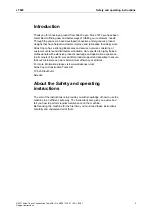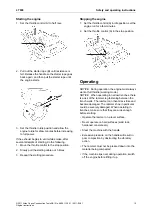
Operating
♦
Set the throttle control (A) to full revs and the
rammer will start to move forward.
Steer the rammer with the handle (B).
A
B
♦
Make sure the rammer shoe (C) is impacting
parallel to the ground.
C
♦
Never overload or force the machine.
When taking a break
♦
Stop the machine during breaks.
♦
During all breaks you must put the machine away
so that there is no risk for unintentional start.
Maintenance
Regular maintenance is a basic requirement for the
continued safe and efficient use of the machine.
Follow the maintenance instructions carefully.
♦
Before starting maintenance on the machine, clean
it in order to avoid exposure to hazardous
substances. See “Dust and fume hazards”
♦
Use only authorised parts. Any damage or
malfunction caused by the use of unauthorised
parts is not covered by warranty or product liability.
♦
When cleaning mechanical parts with solvent,
comply with appropriate health and safety
regulations and ensure there is satisfactory
ventilation.
♦
For major service of the machine, contact your
nearest authorised workshop.
♦
After each service, check that the machine's
vibration level is normal. If not, contact your
nearest authorised workshop.
NOTICE
Never aim a water jet directly at the fuel
filler cap. This is particularly important when using a
high-pressure cleaner.
Cleaning the machine
♦
Do not spray water directly onto electrical
components or the instrument panel.
♦
Place a plastic bag over the fuel filler cap and
secure with a rubber band. (This will prevent water
from entering the venting hole in the filler cap.
Otherwise this could cause operational
disturbances, such as clogged filters.)
Every 10 hours of operation
(daily)
Daily maintenance routines before starting up:
♦
Check that leakages or other faults are detected
and rectified.
♦
Check the ground under the machine. Leakages
are more easily detected on the ground than on
the machine itself.
♦
Check and replenish fuel and engine oil. See the
engine manual for more information.
♦
Check and clean the air filter.
♦
Check the tightness of all nuts and bolts.
♦
Check that the machine is clean.
♦
Check or clean the engine's cooling flanges. See
the engine manual for more information.
♦
Check that the controls are not damaged or do
not jam.
© 2011 Atlas Copco Construction Tools AB | No. 9800 1139 01 | 2011-04-01
Original instructions
16
LT 800
Safety and operating instructions



























